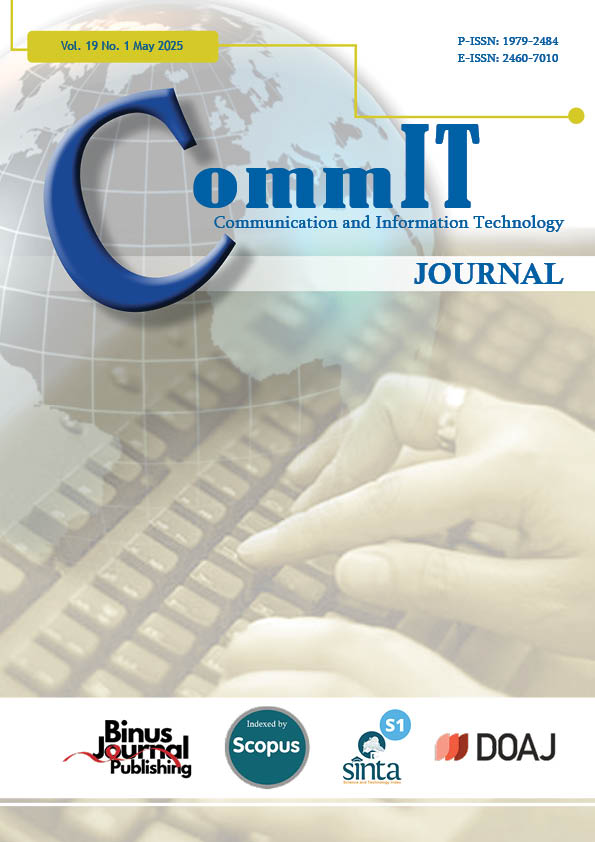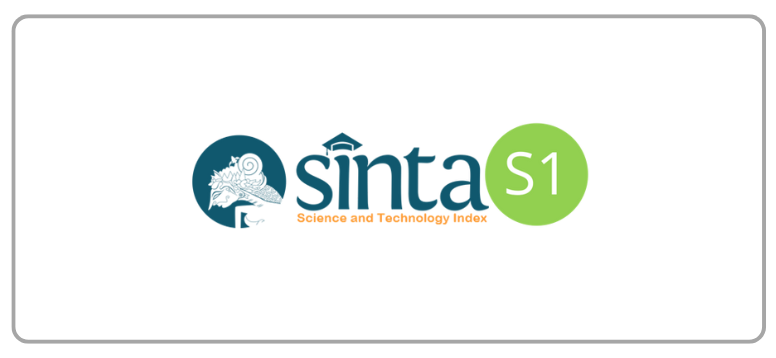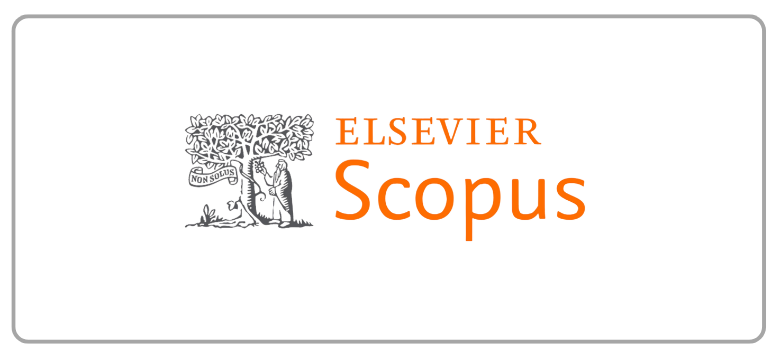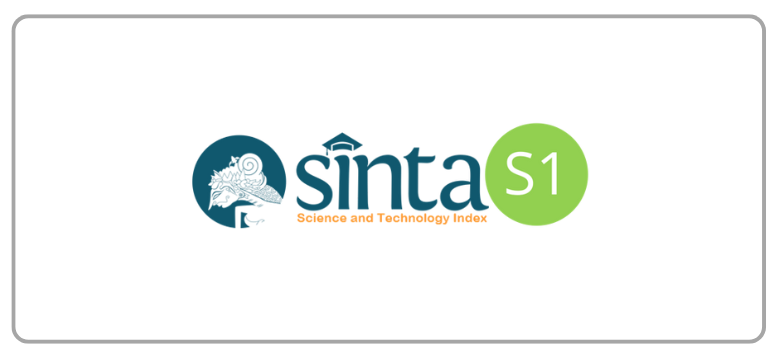Improved Classification of Arsenic-Affected Skin Diseases Through Image Processing and Transfer Learning
DOI:
https://doi.org/10.21512/commit.v19i1.11891Keywords:
Arsenic-Affected Skin Diseases, Image Processing, Transfer LearningAbstract
Arsenic contamination of groundwater is a global health concern, leading to adverse health effects, including skin diseases. Early detection is crucial for prevention and treatment, although manual methods are often time-consuming and error-prone. To address this issue, deep learning methods, specifically transfer learning, offer a promising solution for accurate and efficient skin disease detection. Therefore, the research aims to propose a comprehensive framework that uses ResNet152V2 architecture along with Gaussian smoothing methods to improve the classification accuracy of skin images exposed to arsenic. ResNet152V2 model is pre-trained on large-scale image datasets, providing powerful feature extraction fine-tuned on the ArsenicSkinBD dataset. The images are preprocessed using Gaussian smoothing to reduce noise and enhance feature clarity. Specifically, the research introduces the innovative application of Gaussian smoothing along with transfer learning for skin disease classification, which has not been extensively explored in previous studies. The results show a significant increase in classification accuracy, achieving approximately 0.9904 on the testing set compared to 0.9881 without enhancements. This improvement shows the effectiveness of the method in detecting skin diseases caused by arsenic exposure. The use of Gaussian smoothing also reduces loss values on the testing set, indicating that the model becomes more efficient in optimizing its predictions. The proposed framework not only enhances detection accuracy but also supports more efficient diagnostic processes, contributing to better prevention and treatment efforts.
References
[1] Y. Chen, F. Parvez, M. Gamble, T. Islam, A. Ahmed, M. Argos, J. H. Graziano, and H. Ahsan, “Arsenic exposure at low-to-moderate levels and skin lesions, arsenic metabolism, neurological functions, and biomarkers for respiratory and cardiovascular diseases: Review of recent findings from the Health Effects of Arsenic Longitudinal Study (HEALS) in Bangladesh,” Toxicology and Applied Pharmacology, vol. 239, no. 2, pp. 184–192, 2009.
[2] W. K. Chowdhury, A. Tisha, S. Akter, S. Zahur, N. Hasan, A. S. Mahadi, S. M. F. Rabby, M. M. Mohib, M. A. T. Sagor, and S. Mohiuddin, “The role of arsenic on skin diseases, hair fall and inflammation: An immunological review and case studies,” Journal of Clinical & Experimental Dermatology Research, vol. 8, no. 2, pp. 1–9, 2017.
[3] Y. Zhang, B. Xu, Z. Guo, J. Han, H. Li, L. Jin, F. Chen, and Y. Xiong, “Human health risk assessment of groundwater arsenic contamination in Jinghui irrigation district, China,” Journal of Environmental Management, vol. 237, pp. 163–169, 2019.
[4] S. Prakash and A. K. Verma, “Arsenic: It’s toxicity and impact on human health,” International Journal of Biological Innovations (IJBI), vol. 3, no. 1, pp. 38–47, 2021.
[5] R. Ashraf, S. Afzal, A. U. Rehman, S. Gul, J. Baber, M. Bakhtyar, I. Mehmood, O. Y. Song, and M. Maqsood, “Region-of-interest based transfer learning assisted framework for skin cancer detection,” IEEE Access, vol. 8, pp. 147 858–147 871, 2020.
[6] H. E. Kim, A. Cosa-Linan, N. Santhanam, M. Jannesari, M. E. Maros, and T. Ganslandt, “Transfer learning for medical image classification: A literature review,” BMC Medical Imaging, vol. 22, no. 1, pp. 1–13, 2022.
[7] L. Alzubaidi, M. Al-Amidie, A. Al-Asadi, A. J. Humaidi, O. Al-Shamma, M. A. Fadhel, J. Zhang, J. Santamar´ıa, and Y. Duan, “Novel transfer learning approach for medical imaging with limited labeled data,” Cancers, vol. 13, no. 7, pp. 1–22, 2021.
[8] S. A. AlDera and M. T. B. Othman, “A model for classification and diagnosis of skin disease using machine learning and image processing techniques,” International Journal of Advanced Computer Science and Applications, vol. 13, no. 5, pp. 252–259, 2022.
[9] Y. Gu, Z. Ge, C. P. Bonnington, and J. Zhou, “Progressive transfer learning and adversarial domain adaptation for cross-domain skin disease classification,” IEEE Journal of Biomedical and Health Informatics, vol. 24, no. 5, pp. 1379–1393, 2019.
[10] I. Kousis, I. Perikos, I. Hatzilygeroudis, and M. Virvou, “Deep learning methods for accurate skin cancer recognition and mobile application,” Electronics, vol. 11, no. 9, pp. 1–19, 2022.
[11] Q. Zeng and A. Zhang, “Assessing potential mechanisms of arsenic-induced skin lesions and cancers: Human and in vitro evidence,” Environmental Pollution, vol. 260, 2020.
[12] M. K. Hasan, M. T. E. Elahi, M. A. Alam, M. T. Jawad, and R. Mart´ı, “DermoExpert: Skin lesion classification using a hybrid convolutional neural network through segmentation, transfer learning, and augmentation,” Informatics in Medicine Unlocked, vol. 28, pp. 1–17, 2022.
[13] K. M. Hosny, M. A. Kassem, and M. M. Foaud, “Classification of skin lesions using transfer learning and augmentation with Alex-Net,” PLOS ONE, vol. 14, no. 5, pp. 1–17, 2019.
[14] K. M. Hosny, M. A. Kassem, and M. M. Fouad, “Classification of skin lesions into seven classes using transfer learning with AlexNet,” Journal of Digital Imaging, vol. 33, pp. 1325–1334, 2020.
[15] A. Khamparia, P. K. Singh, P. Rani, D. Samanta, A. Khanna, and B. Bhushan, “An Internet of health things-driven deep learning framework for detection and classification of skin cancer using transfer learning,” Transactions on Emerging Telecommunications Technologies, vol. 32, no. 7, 2021.
[16] A. Mahbod, G. Schaefer, C. Wang, G. Dorffner, R. Ecker, and I. Ellinger, “Transfer learning using a multi-scale and multi-network ensemble for skin lesion classification,” Computer Methods and Programs in Biomedicine, vol. 193, pp. 1–9, 2020.
[17] M. A. Kassem, K. M. Hosny, and M. M. Fouad, “Skin lesions classification into eight classes for ISIC 2019 using deep convolutional neural network and transfer learning,” IEEE Access, vol. 8, pp. 114 822–114 832, 2020.
[18] M. S. Ali, M. S. Miah, J. Haque, M. M. Rahman, and M. K. Islam, “An enhanced technique of skin cancer classification using deep convolutional neural network with transfer learning models,” Machine Learning with Applications, vol. 5, pp. 1–8, 2021.
[19] A. Jain, A. C. S. Rao, P. K. Jain, and A. Abraham, “Multi-type skin diseases classification using OPDNN based feature extraction approach,” Multimedia Tools and Applications, vol. 81, pp. 6451–6476, 2022.
[20] H. M. Balaha and A. E. S. Hassan, “Skin cancer diagnosis based on deep transfer learning and sparrow search algorithm,” Neural Computing and Applications, vol. 35, no. 1, pp. 815–853, 2023.
[21] G. M. S. Himel, M. M. Islam, K. A. Al-Aff, S. I. Karim, and M. K. U. Sikder, “Skin cancer segmentation and classification using vision transformer for automatic analysis in dermatoscopybased noninvasive digital system,” International Journal of Biomedical Imaging, vol. 2024, no. 1, pp. 1–18, 2024.
[22] P. Thapar, M. Rakhra, M. Alsaadi, A. Quraishi, A. Deka, and J. V. N. Ramesh, “A hybrid grasshopper optimization algorithm for skin lesion segmentation and melanoma classification using deep learning,” Healthcare Analytics, vol. 5, pp. 1–17, 2024.
[23] J. S. T. Purni and R. Vedhapriyavadhana, “EOSANet: A deep learning framework for enhanced multi-class skin cancer classification using optimized convolutional neural networks,” Journal of King Saud University-Computer and Information Sciences, vol. 36, no. 3, pp. 1–25, 2024.
[24] N. V. Y. Lankadasu, D. B. Pesarlanka, A. Sharma, S. Sharma, and S. Gochhait, “Skin cancer classification using a convolutional neural network: An exploration into deep learning,” in 2024 ASU International Conference in Emerging Technologies for Sustainability and Intelligent Systems (ICETSIS). Manama, Bahrain: IEEE, Jan. 28–29, 2024, pp. 1047–1052.
[25] I. A. Emu, N. T. Niloy, B. M. A. Karim, A. Chowdhury, F. T. Johora, M. Hasan, T. Mittra, M. R. A. Rashid, T. Jabid, M. Islam, and M. S. Ali, “ArsenicSkinImageBD: A comprehensive image dataset to classify affected and healthy skin of arsenic-affected people,” Data in Brief, vol. 52, pp. 1–11, 2024.
[26] N. T. Niloy, I. A. Emu, A. Chowdhury, B. M. A. Karim, F. T. Johora, M. R. A. Hasan, Mahamudul Rashid, T. Mittra, T. Jabid, M. Islam, and S. Ali, “ArsenicSkinImageBD,” 2023. [Online]. Available: https://data.mendeley.com/datasets/x4hgnjj5gv/2
[27] S. Saponara and A. Elhanashi, “Impact of image resizing on deep learning detectors for training time and model performance,” in International Conference on Applications in Electronics Pervading Industry, Environment and Society. Springer, 2021, pp. 10–17.
[28] M. Xiao, S. Zheng, C. Liu, Y. Wang, D. He, G. Ke, J. Bian, Z. Lin, and T. Y. Liu, “Invertible image rescaling,” in Computer Vision–ECCV 2020: 16th European Conference. Glasgow, UK: Springer, Aug. 23–28, 2020, pp. 126–144.
[29] B. Desai, M. Paliwal, and K. K. Nagwanshi, “Study on image filtering—Techniques, algorithm and applications,” 2022. [Online]. Available: https://arxiv.org/abs/2207.06481
[30] B. H. Chen, Y. S. Tseng, and J. L. Yin, “Gaussianadaptive bilateral filter,” IEEE Signal Processing Letters, vol. 27, pp. 1670–1674, 2020.
[31] C. Shorten and T. M. Khoshgoftaar, “A survey on image data augmentation for deep learning,” Journal of Big Data, vol. 6, no. 1, pp. 1–48, 2019.
[32] A. Krizhevsky, I. Sutskever, and G. E. Hinton, “ImageNet classification with deep convolutional neural networks,” Communications of the ACM, vol. 60, no. 6, pp. 84–90, 2017.
[33] F. Zhuang, Z. Qi, K. Duan, D. Xi, Y. Zhu, H. Zhu, H. Xiong, and Q. He, “A comprehensive survey on transfer learning,” Proceedings of the IEEE, vol. 109, no. 1, pp. 43–76, 2020.
[34] S. Athisayamani, R. S. Antonyswamy, V. Sarveshwaran, M. Almeshari, Y. Alzamil, and V. Ravi, “Feature extraction using a residual deep convolutional neural network (ResNet-152) and optimized feature dimension reduction for MRI brain tumor classification,” Diagnostics, vol. 13, no. 4, pp. 1–20, 2023.
[35] H. Yu, X. Miao, and H. Wang, “Bearing fault reconstruction diagnosis method based on ResNet-152 with multi-scale stacked receptive field,” Sensors, vol. 22, no. 5, pp. 1–14, 2022.
[36] V. Thakkar, S. Tewary, and C. Chakraborty, “Batch normalization in convolutional neural networks—A comparative study with CIFAR-10 data,” in 2018 Fifth International Conference on Emerging Applications of Information Technology (EAIT). Kolkata, India: IEEE, Jan. 12–13 2018, pp. 1–5.
[37] X. Xu, W. Li, and Q. Duan, “Transfer learning and SE-ResNet152 networks-based for smallscale unbalanced fish species identification,” Computers and Electronics in Agriculture, vol. 180, 2021.
[38] K. He, X. Zhang, S. Ren, and J. Sun, “Deep residual learning for image recognition,” in Proceedings of the IEEE Conference on Computer Vision and Pattern Recognition, Las Vegas, June 26–July 1, 2016, pp. 770–778.
[39] Y. Cui, M. Jia, T. Y. Lin, Y. Song, and S. Belongie, “Class-balanced loss based on effective number of samples,” in Proceedings of the IEEE/CVF Conference on Computer Vision and Pattern Recognition, Long Beach, CA, June 16–20, 2019, pp. 9268–9277.
[40] L. S. Bernardo, R. Damaˇseviˇcius, V. H. C. De Albuquerque, and R. Maskeli¯unas, “A hybrid twostage SqueezeNet and support vector machine system for Parkinson’s disease detection based on handwritten spiral patterns,” International Journal of Applied Mathematics and Computer Science, vol. 31, no. 4, pp. 549–561, 2021.
[41] M. Ahammed, M. Al Mamun, and M. S. Uddin, “A machine learning approach for skin disease detection and classification using image segmentation,” Healthcare Analytics, vol. 2, pp. 1–15, 2022.
[42] M. Shahin, F. F. Chen, A. Hosseinzadeh, H. K. Koodiani, A. Shahin, and O. A. Nafi, “A smartphone-based application for an early skin disease prognosis: Towards a lean healthcare system via computer-based vision,” Advanced Engineering Informatics, vol. 57, 2023.
[43] M. Wei, Q. Wu, H. Ji, J. Wang, T. Lyu, J. Liu, and L. Zhao, “A skin disease classification model based on DenseNet and ConvNeXt fusion,” Electronics, vol. 12, no. 2, pp. 1–19, 2023.
[44] A. M. Vidhyalakshmi and M. Kanchana, “Classification of skin disease using a novel hybrid flash butterfly optimization from dermoscopic images,” Neural Computing and Applications, vol. 36, no. 8, pp. 4311–4324, 2024.
[45] A. De, N. Mishra, and H. T. Chang, “An approach to the dermatological classification of histopathological skin images using a hybridized CNN-DenseNet model,” PeerJ Computer Science,
vol. 10, pp. 1–33, 2024.
[46] Q. Su, H. N. A. Hamed, M. A. Isa, X. Hao, and X. Dai, “A GAN-based data augmentation method for imbalanced multi-class skin lesion classification,” IEEE Access, vol. 12, pp. 16 498–16 513, 2024.
Downloads
Published
How to Cite
Issue
Section
License
Copyright (c) 2025 Rudi Kurniawan, Samsuryadi, Fatma Susilawati Mohamad

This work is licensed under a Creative Commons Attribution-ShareAlike 4.0 International License.
Authors who publish with this journal agree to the following terms:
a. Authors retain copyright and grant the journal right of first publication with the work simultaneously licensed under a Creative Commons Attribution License - Share Alike that allows others to share the work with an acknowledgment of the work's authorship and initial publication in this journal.
b. Authors are able to enter into separate, additional contractual arrangements for the non-exclusive distribution of the journal's published version of the work (e.g., post it to an institutional repository or publish it in a book), with an acknowledgment of its initial publication in this journal.
c. Authors are permitted and encouraged to post their work online (e.g., in institutional repositories or on their website) prior to and during the submission process, as it can lead to productive exchanges, as well as earlier and greater citation of published work.
Â
USER RIGHTS
All articles published Open Access will be immediately and permanently free for everyone to read and download. We are continuously working with our author communities to select the best choice of license options, currently being defined for this journal as follows: Creative Commons Attribution-Share Alike (CC BY-SA)




















